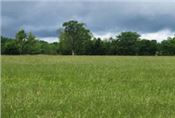May A Key Time For Pastures As Grasses Make Warm-Season Transition
LITTLE ROCK, ARK.
Arkansas’ hay and forage producers will have to wait until the mud dries to perform some key actions to get their warm-season grasses going.
“We recommend waiting to fertilize bermuda and other warm season grasses until the night temps are 60-plus degrees Fahrenheit for a week,” said John Jennings, professor and extension forage specialist for the University of Arkansas System Division of Agriculture. “That is finally happening this week, but rain will keep farmers out of the fields. So as soon as fields conditions allow, fertilizer should be applied to those forages.”
Jennings said growers should try to get their fescue and ryegrass out of the field “as soon as conditions allow to prevent quality losses from advancing maturity and, in mixed fields, to allow any underlying bermuda to receive sunshine to begin active growth.
“Prolonged delays of harvesting ryegrass can drastically stunt and delay bermuda growth well into summer due to excessive shading,” he said.
May is also a time for producers to get bermuda or crabgrass in the ground for summer forage.
“Fields should be prepped by getting the sod under control and to make certain there is no existing common bermudagrass,” he said.
“Any existing bermuda will overtake any new bermuda variety that is planted which will make the upgrade to a better variety pointless.”
Download the fact sheets “Crabgrass for Forage,” https://www.uaex.edu/publications/pdf/FSA-3138.pdf and “Establishing Bermudagrass for Forage,” https://www.uaex.uada.edu/publications/pdf/FSA-19.pdf ∆

Fescue awaiting harvest, which is delayed due to repeated rains.
U of A System Division of Agriculture image by Nicole Nichols.